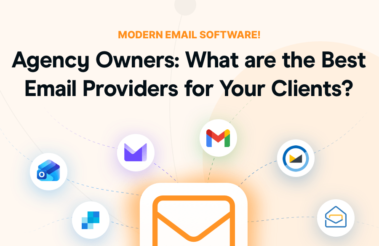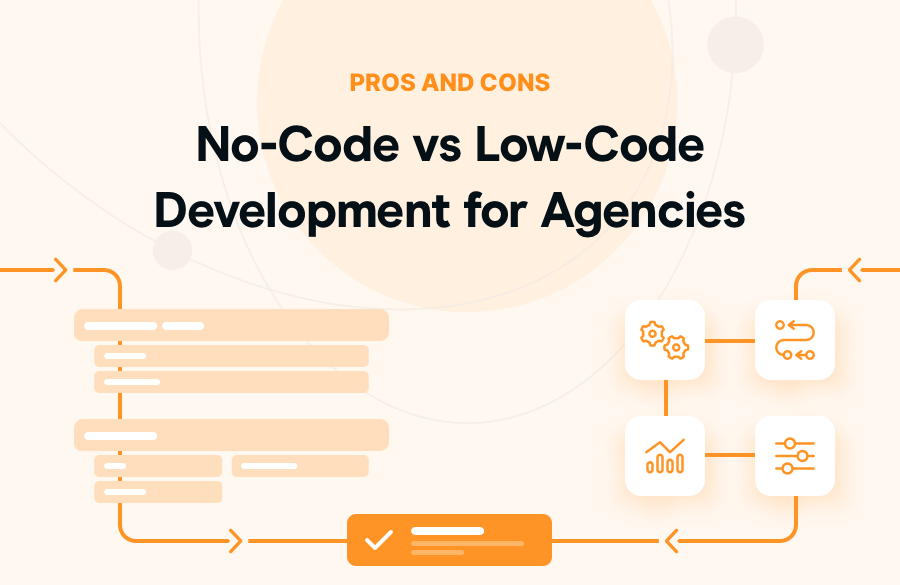
Agency Owners: What are the Best Email Providers for Your Clients?
- •
- 6 min read

You drag and drop elements, click “publish,” and build a WordPress site without a line of code. So, you’re a developer now, right?
Hold up. That’s like saying you’re a chef because you used a Thermomix. Sure, you got something done, and that’s great! You can’t test what you didn’t produce. But today, that approach can either be your secret weapon or your biggest liability.
No-code and low-code tools are all anyone is talking about. Oxygen, Bricks, Beaver Builder — even AI assistants are cranking out websites faster than you can say “responsive design.” But hold the phone: speed without strategy is just expensive chaos.
Your clients want sites that load instantly, convert like crazy, and don’t break when traffic spikes. One bloated page builder, one security vulnerability, and your quick win just became your biggest headache.
If your WordPress strategy hasn’t evolved beyond “drag, drop, done,” you’re setting yourself up for failure. Let’s fix that.
No-code means building entirely without writing code – think drag-and-drop interfaces and pre-built templates. Anyone can use them.
When to Use No Code? You have no programming experience and need a simple, cost-effective solution for quick prototyping or basic business applications – like a website.
Low-code allows some customization through minimal coding or configuration. You get more flexibility without full development complexity.
When to Use Low Code? You have some coding knowledge and need customizable, scalable applications built quickly with the flexibility to refine them later.
WordPress sits at the intersection of both no-code and low-code. Use the Block Editor without touching code (no-code). Add custom fields or snippets for extra functionality (low-code). WordPress adapts to your skill level and project needs.
Your competition is already using these tools to launch faster, bid lower, and take on more clients.
This is about business:
No-code/low-code isn’t a shortcut — it’s how your agency can scale.
“Anyone who can benefit from software that helps them to get their job done can benefit from no-code software development.”
Blaze
WordPress success today comes from combining the right tools with a smart strategy.
Here’s what’s working:
WordPress’s built-in tools now handle complex layouts without plugins. The Site Editor designs entire page structures visually.
But: speed matters more than features. Clients don’t care about elegant code; they care about results. Launch campaign pages in hours, not weeks. Test market demand before investing in custom development.
Your move: Master WordPress core tools first. Most agencies overcomplicate when simple solutions exist. Build fast, optimize immediately.
Related Article: Are Agencies Using The Gutenberg Block Editor? – Rocket.net
Advanced Custom Fields turns WordPress into a content powerhouse. Team bios, product specs, custom layouts – all without PHP.
This creates citizen developers: non-technical people building business solutions. Your designer builds prototypes. Your content team updates layouts. Clients make changes without calling you.
Your move: Train your team, set guardrails. Show clients what they can safely change. Make clear what needs professional help.
Gravity Forms and WS Form power conditional logic, multi-step processes, and user registration through visual interfaces.
Plus, they connect to everything: CRMs, email platforms, eCommerce, and analytics. Zapier talks to Gravity Forms. WooCommerce syncs with inventory systems. Newsletter signups trigger automated sequences. No API documentation required.
Your move: Map your clients’ tool ecosystems. Find connections that save manual work – that’s where no-code shines.
“WooCommerce Block Themes let you completely customize every part of your online store. Create exactly the shopping experience you want without touching a line of code.”
Woo
This Page Builder has kept up with trends from pre-Gutenberg to FSE and is designer-friendly.
Maximum control, minimum bloat, superior performance.
Clean output focusing on user experience and team workflows.
Agency move: Test AI-integrated tools for content and design generation. Maintain quality control. Best results combine AI speed with human strategy.
Hot Tip: Dive into a complete platform comparison and discover which low-code tool will accelerate your business — not slow it down. 12 of the best low-code platforms compared by DreamSoft4U

The Problem: WordPress wasn’t built for complex relational data. Many-to-many relationships get messy fast.
Reality Check: If you need extensive data modeling – think inventory management with complex product variants – WordPress struggles without custom development.
Workaround: Use tools like Pods or Toolset for moderate complexity. For heavy data needs, consider headless WordPress with a separate database.
Visual builders love to pile on features and add Javascript to every page. Every animation, every widget, every “cool effect” adds weight. Your beautiful site becomes a slow site. Your slow site becomes a bounce-rate nightmare.
Reality check: A 3-second load time loses 53% of mobile visitors. Your fancy page builder won’t save you from that math.
Related Article: Core Web Vitals Tips and Tricks Nobody Will Ever Tell You – Rocket.net
The Problem: Low-code builds often require a lot of plugins. Each plugin is a potential security vulnerability or compatibility issue; we call this technical debt.
Reality Check: More plugins mean more maintenance, more update conflicts, and more potential breaking points.
Workaround: Choose well-maintained plugins from reputable developers. Use staging environments for all updates. Consider managed hosting with automatic security monitoring.
Related Article: How Many WordPress Plugins is Too Much? – Rocket.net
Invested heavily in a specific builder’s ecosystem? Congrats! You’re now married to their pricing, their updates, and their business decisions.
Your move: Build templates that aren’t completely dependent on one tool. Keep core functionality portable – including hosting and domain name portability.
Related Article: Introducing Site Templates – Rocket.net
Here’s the truth about when WordPress actually wins (and when you’re fooling yourself):
Webflow: Sure, it looks prettier out of the box. But your client wants to update their blog weekly without calling you. Good luck with that. WordPress wins on content management every single time.
Bubble: Great for MVPs if you love vendor lock-in and monthly fees that scale with your success. WordPress gives you the same functionality with ACF and custom post types – and you own it.
Shopify: Perfect if you want to pay transaction fees forever and can’t customize anything meaningful. WordPress + WooCommerce costs more time upfront but saves thousands of dollars long-term.
The bottom line: WordPress wins when you need real flexibility, when budgets matter, and when clients want to really own their websites.
WordPress dominates when:
Stop building brochure sites. Start building systems that pay you monthly.
Reality check: Companies like Copyblogger run million-dollar membership platforms on WordPress.
MemberPress + custom post types = no custom code needed.
Your move: Build training portals for corporations. Use LearnDash and custom fields. Your client will pay for monthly maintenance. That’s real money.
What actually works:
Here’s what smart agencies do: You’re a real estate agency. Ditched your expensive CRM and built everything in WordPress.
Advanced Custom Fields + Admin Columns Pro = agents manage their own leads.
Result? Go from 40 hours/month of data entry to zero. Bill monthly for system maintenance instead.
Win-Win for everyone:
Stop leaving money on the table: Every salon, consultant, and fitness studio needs scheduling. Amelia Booking handles the complex stuff — staff management, payment processing, automated reminders.
Your move: Target service businesses with recurring booking needs.
Installation fee + monthly maintenance = predictable income that scales.
Money-making features:
The old way: You spend 3 weeks building a basic brochure site. Client pays a premium for simple functionality.
The no-code winner: Launch MVP site in 2 days using FSE and proven templates. Client sees immediate results, upgrades to custom features. You take on 3x more projects.
Bottom line: Speed builds trust; trust builds bigger contracts.
“Potential clients are drowning in options. How can you tell one agency from another? They default to price shopping because, well, what else can they compare? Clients don’t buy websites. They buy solutions.”
Rocket.net – Top 8 Ways to Make Your WordPress Agency Stand Out
Don’t pick tools because they’re popular. Pick them because they solve specific problems.
Lightweight themes (OllieWP, Neve) + flexible builders (Beaver Builder, Bricks) + performance hosting = winning combination.
Create reusable starting points for common industries: restaurants, consultants, eCommerce, and nonprofits.
Speed up every project while maintaining quality standards.
Monitor load times religiously. Optimize images automatically. Use CDNs and caching from day one.
Beautiful sites that load slowly convert poorly. Fast sites with decent design convert well.
Start with no-code MVPs. Identify what needs custom development as sites grow. Budget for both phases from the beginning.
“Rocket.net Ranks No. 167 on the 2025 Inc. 5000 List of America’s Fastest-Growing Private Companies. We’re not only the fastest-growing managed hosting for WordPress company in the nation for 2025, but one of the fastest-growing hosting companies in history.”
Rocket.net
Visual builders need serious infrastructure to perform. That’s non-negotiable.
What you need:
Choosing the wrong hosting for your portfolio of websites is like going into space without a spacesuit. A good, managed WordPress host ensures your websites load quickly.
Performance matters: Speed and support. If you currently have over 20 websites hosted, some with fairly high traffic, they should load extremely fast. Security is key.
Security is critical: Having an Enterprise WAF and real-time malware scanning on every website is a game-changer.
Support saves time: 24/7 access to human support isn’t just a luxury; it’s a necessity. Automation and AI should complement, not replace, your human support team.
Yes, if you want fast, cost-effective builds with easy control.
Add custom development when you need to scale or add complexity.
The smartest path blends both. Start fast with no-code, scale with code — and always back it with hosting that makes performance a priority.
Ready to build smarter? Choose your tools carefully, optimize relentlessly, and watch your agency results take off.
